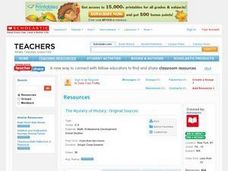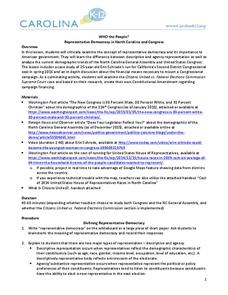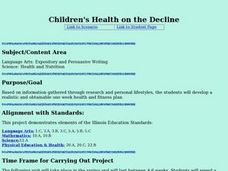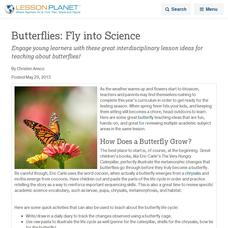Curated OER
The Mystery of History-Original Sources
Students research the events surrounding the Alamo in 1863, and explore the differences between primary and secondary sources of information. They brainstorm lists of items used to research a subject and categorize them as primary or...
Curated OER
Changing Seasons
Explore expository writing and using precise language in this descriptive paragraph writing lesson. Learners brainstorm prior knowledge about the changing seasons in Ohio. They describe seasonal items, view seasonal pictures from...
Curated OER
Saving Sturgeon
Marine biology apprentices interpret data of sturgeon interaction with gill nets. They use the data to calculate the percentage of fish entangled in each twine size to discover if there is any correlation. This is a valuable exercise in...
Carolina K-12
Who the People? Representative Democracy in North Carolina and Congress
Our elected officials are supposed to represent us, but what does it mean when they aren't like us? Budding citizens explore the demographic makeup of the US Congress, the role of money in political elections, and the Citizens United...
Curated OER
Children's Health on the Decline
Demonstrate the importance of children's health with this cross-curricular lesson, which includes elements from health and science as well as expository writing. Middle schoolers develop realistic and obtainable one week health and...
Curated OER
Informative Writing for the Winter Season
Informational writing lessons can be creative and motivating for students.
Curated OER
Double-Entry Journal Writing
Introduce your learners to the concept of a double-entry journal. Talk about how to connect with the text and model an example for them. Using whatever literature you are working with, have scholars choose a quote and make their own...
Cornell University
Too Much of a Good Thing?
Continuing their study of beneficial insects, young entomologists discover where in the world some of these bugs are. By labeling, coloring, and using the scale on a map, pupils explore the territories and arrival of the Asian lady...
Curated OER
Appreciation Cards
Students discuss jobs in which have impacted their lives directly. They create appreciation cards for a person who they believe needs appreciation. They give their cards to that person and share their reaction with the class.
Curated OER
Graphing San Diego Tides
Students observe the tides in San Diego for one month. Using this information, they graph the tides on a chart along with the phases of the moon. They answer questions related to the graph to end the lesson.
Curated OER
Make a Dried Bouquet
Students examine how drying flowers was a popular hobby for Colonial women during the Colonial era in America. They read and discuss an instruction sheet, and create dried-flower bouquets that are hung upside down and tied with a string.
Curated OER
Tracking the Salt Front
Students manipulate Hudson River salt front data from October 2004 -
September 2005 to locate the high and low points of the salt front for each month, They determine the range for each month, determine the modal range for each month,...
Curated OER
Level Two ITIP (DM)
Students, while working in groups, recognize how to use a decision making process to make positive and healthy decisions concerning health issues. They brainstorm reasons for choosing drugs, witness a decision making power point and...
Curated OER
No Title
Sixth graders explore, analyze and explain self concept and five ways that alcohol harms the body. They assess the relationship between positive health behaviors and the prevention of injury, illness, disease, and other health problems.
Curated OER
"In Defense of My Race and Country": African-American Soldiers on Why They Are Fighting
Why would an African-American slave fight in the Civil War? Read and analyze primary source documents to understand the ex-slave perspective on fighting in the Union Army. Everything to complete this lesson is included.
Curated OER
Water Cycle Reading and Writing
After listening to a story about the water cycle, learners create their own versions of this tale. This is a great way to have your class review the concepts of evaporation, condensation, precipitation, and runoff.
Curated OER
Vocabulary and Concept Development
Considering a lesson on Greek and Latin roots and affixes? The Latin roots bas and pos, and the Greek root bas are the focus on a colorful, animated presentation that will engage your learners and provide guided and independent practice...
Curated OER
Butterflies: Fly into Science
Engage young learners with these great interdisciplinary lesson ideas for teaching about butterflies!
Curated OER
Our Classroom Constitution
Develop a system of classroom rules created by the kids, for the kids with this three-part instructional activity series on the US Constitution. After learning about the structure of the Constitution and the government it established,...
American Museum of Natural History
Volcanoes Magma Rising
Get ready for an explosive lesson! Learners read and interact with an online lesson describing the characteristics of volcanoes. They study specific historical volcanoes as well as the science of volcanic eruptions using animations and...
Curated OER
Pattern Puzzlers
Students identify triangles, circles, and squares, then show their understanding of patterns by continuing a pattern that contains three different elements. They utilize worksheets imbedded in this plan to practice using these shapes.
Curated OER
Sprouting Sprouts!
Learners plant sprout seeds and make observations. In this lesson about planting, students make observations, predictions, and record information. Learners analyze how the sprout plants grow and determine if any of the four sprout seeds...
Curated OER
A Dialogue With Your Lettuce
Students, in groups, create questions they would ask about a head of lettuce in their refrigerator (e.g., Where were you grown? Who picked you? What were the working conditions?). They exchange questions with another group and then...
Curated OER
One in a Million
Students participate in an experiment to demonstrate how a substance can have different concentrations in a solution. Students record observations on a dilution chart and determine the concentations of various parts per million.

























